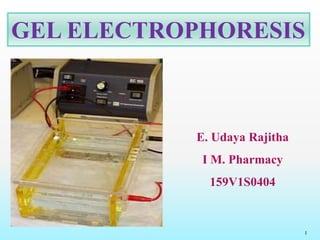Report
Share

Recommended
Recommended
More Related Content
What's hot
What's hot (20)
Similar to gel electrophoresis
Similar to gel electrophoresis (20)
electrophoresis: types, advantages, disadvantages and applications.

electrophoresis: types, advantages, disadvantages and applications.
Gel Electrophoresis, ITS FACTOR AFFECTING, ITS TYPES,NORMAL METHODOLOGY, PAGE

Gel Electrophoresis, ITS FACTOR AFFECTING, ITS TYPES,NORMAL METHODOLOGY, PAGE
Electrophoresis and its types and its importance in Genetic engineering

Electrophoresis and its types and its importance in Genetic engineering
Gel Electrophoresis (suchita rawats conflicted copy 2023-04-28) (1).pptx

Gel Electrophoresis (suchita rawats conflicted copy 2023-04-28) (1).pptx
More from udaya rajitha
More from udaya rajitha (9)
Reagents & reactions in estimation of pharmaceuticals

Reagents & reactions in estimation of pharmaceuticals
Smart and strong women for quality pharmaceutical industry 

Smart and strong women for quality pharmaceutical industry
gel electrophoresis
- 1. GEL ELECTROPHORESIS E. Udaya Rajitha I M. Pharmacy 159V1S0404 1
- 2. CONTENTS Introduction Principle Types of gels Preparation and running of agarose gel Sampling Instrument & Working Applications 2
- 3. Introduction • Positive and negative electrical charges are frequently associated with biomolecules. When placed in an electric field, charged biomolecules move towards the electrode of opposite charge due to the phenomenon of electrostatic attraction. • Electrophoresis is the separation of charged molecules in an applied electric field. 3
- 4. Types of electrophoresis: Moving boundary electrophoresis Zone electrophoresis - Paper electrophoresis - Gel electrophoresis Based on the supporting medium there are two types of electrophoresis. 4
- 5. Principle: It is type of separation technique, in this separation of components are carried out by the migration of charged particles under the influence of electric field with some migration velocity. Electrophoretic mobility ( ue ) = 6 πŋr q q = Charge ŋ = Viscosity of solution r = Radius of particle 5
- 6. Types of gels: Agarose gel: For separating larger nucleic acids. Polyacrylamide gel: For separating smaller nucleic acids. - SDS-PAGE - for denaturing the proteins. Starch: Non-denatured proteins can be separated according to charge and size. 6
- 7. Type Source Use Concentration Agarose Polysaccharide polymer extracted from seaweed Separate the proteins ranging in size from 200 kDa 0.7 % - large DNA 2 % - small fragments Polyacrylamide Chemical polymerization reaction Separating proteins ranging in size from 5 to 2,000 kDa 6 %, 8 %, 10 %, 12 % Starch Potato starch proteins can be separated 5-10% 7
- 8. • Denaturing gels are run under conditions that disrupt the natural structure of the analyte, causing it to unfold into a linear chain. • Denaturing conditions are necessary for proper estimation of molecular weight of RNA. • Urea , DMSO and glyoxal are the most often used denaturing agents to disrupt RNA structure. Denaturing: • Originally, highly toxic methyl mercury hydroxide was often used in denaturing RNA electrophoresis 8
- 9. Preparation & running of gel 9
- 10. Preparing acryl amide gels: Acryl amide + bisacryl amide + denaturant + buffer Polymerization Add butanol • Butanol removes bubbles and makes the surface smooth. • Gels are usually polymerized between two glass plates in a gel caster, with a comb inserted at the top to create the sample wells. After the gel is polymerized the comb can be removed and the gel is ready for electrophoresis. 10
- 11. • Buffers in gel electrophoresis are used to provide ions that carry a current and to maintain the pH at a relatively constant value. • Tris/Acetate/EDTA (TAE), • Tris/Borate/EDTA(TBE). Buffers : 11
- 12. The sample to analyse is optionally mixed with a chemical denaturant if so desired, usually SDS for proteins or urea for nucleic acids. Sampling: Then the samples are allow to fall in to the sample wells. 12
- 13. Instrument and working • An electric field is applied across the gel, causing the negatively charged proteins or nucleic acids to migrate across the gel away from the negative electrode. • Smaller biomolecules travel farther down the gel, while larger ones remain closer to the point of origin. 13
- 14. Visualization: • DNA may be visualized using ethidium bromide which, when intercalated into DNA, fluorescence under ultraviolet light, while protein may be visualized using silver stain or Coomassie Brilliant Blue dye. • PAGE of rotavirus proteins stained with Coomassie blue 14
- 15. • After separation, an additional separation method may be used. The gel will then be physically cut, and the protein complexes extracted from each portion separately. • This can provide a great deal of information about the identities of the proteins in a complex. Downstream processing: 15
- 16. Applications: • Gel electrophoresis is used in forensics, molecular biology, genetics, microbiology and biochemistry. • Estimation of the size of DNA molecules following restriction enzyme digestion, e.g. in restriction mapping of cloned DNA. • Analysis of lipo proteins. • Used in DNA fingerprinting. 16
- 17. • Separation of organic acids, alkaloids, carbohydrates, amino acids, nucleic acids. • Used for DNA sequencing. • Separation of serum proteins. • Also used in antigen-antibody studies. • Used in food industry. • Used to study the protein mixtures. 17
- 18. Conclusion 18
- 19. References: •Instrumental methods of chemical analysis by B. K. Sharma; chapter-13 ( Pg. no. C-268, 269, C-280,281 ). •Instrumental analysis by skoog, Holler, Crouch; chapter-30 ( Pg. no. 946, 947 ). •Skoog & west fundamentals of analytical chemistry by F. James Holler Stanley R. Crouch; chapter-34 ( Pg. no. 942 ). •Gel electrophoresis & its applications by Pulimamidi rabindra reddy and Nomula Raju. • Poly acryl amide gel electrophoresis from Wikipedia, the free encyclopedia. 19
- 20. THANK YOU 20